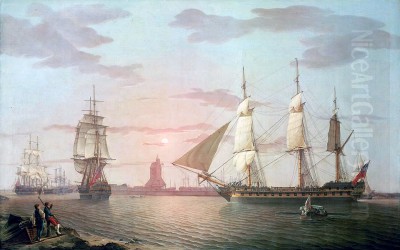
Robert Salmon stands as a pivotal figure in the history of marine painting, a skilled artist whose career bridged the traditions of Great Britain and the burgeoning artistic landscape of the United States. Born in England in 1775 and active until around 1844, Salmon meticulously documented the maritime world of his time, from the grandeur of British naval power to the bustling energy of American harbors. His unique style, characterized by precise detail and a remarkable sensitivity to light and atmosphere, not only captured the visual reality of ships and sea but also significantly influenced a generation of American painters, laying groundwork for the Luminist movement. This exploration delves into the life, work, and enduring legacy of this transatlantic master.
The Early Years in Britain
Robert Salmon's journey began in the maritime environment of England. Born Robert Salomon on November 5, 1775, in Whitehaven, Cumberland (though some earlier sources suggested St. James Parish, Cambridgeshire), he was immersed from a young age in the sights and sounds of a busy port town. Whitehaven, a significant harbor on England's northwest coast, would have provided ample inspiration, exposing him to the constant traffic of merchant vessels and naval ships that were crucial to Britain's power and economy during the late 18th and early 19th centuries. It is likely here that his fascination with the sea and the vessels that navigated it took root.
Details about his formal artistic training remain somewhat scarce, but it is evident that he absorbed the prevailing traditions of British marine painting. He likely studied the works of established masters and honed his skills through practice and observation. By 1800, he was producing accomplished works, such as Two Armed Merchantmen Leaving Whitehaven, demonstrating a clear talent for detailed ship portraiture and the dynamic representation of water and sky. This early piece already hints at the precision and careful composition that would become hallmarks of his style.
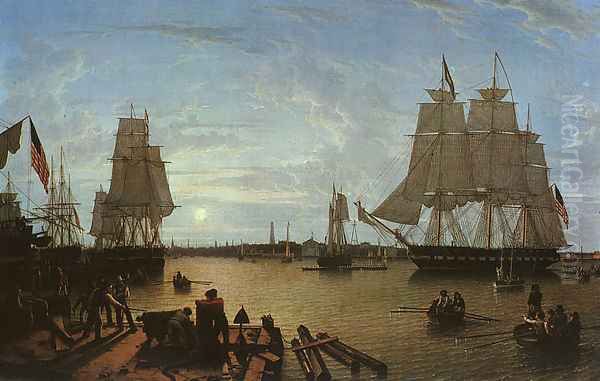
His early career saw him move between key maritime centers. He spent time in London, the heart of the British art world, before relocating to the thriving port of Liverpool around 1806. Liverpool's docks, crowded with ships from around the globe, offered endless subject matter. It was during his Liverpool period that Salmon began systematically numbering his paintings, a practice he maintained throughout his career, providing invaluable documentation for later scholars tracking his prolific output. His time in Liverpool coincided with Britain's intense naval engagement during the Napoleonic Wars, a period reflected in works like his depiction of the Battle of Trafalgar, celebrating Nelson's famous victory in 1805.
Salmon's development was undoubtedly shaped by the giants of marine art who preceded and surrounded him. The influence of 17th-century Dutch masters, particularly Willem van de Velde the Elder and Willem van de Velde the Younger, known for their meticulous accuracy and atmospheric seascapes, is apparent in Salmon's attention to nautical detail. He also absorbed lessons from prominent British marine painters like Nicholas Pocock, Thomas Luny, and Thomas Whitcomb, who specialized in depicting naval battles and ship portraits with dramatic flair and technical proficiency. The rising star of British art, J.M.W. Turner, whose revolutionary approach to light and atmosphere was transforming landscape and marine painting, may also have offered inspiration, though Salmon's path would ultimately favor clarity and precision over Turner's more expressive romanticism.
After approximately five years in Liverpool, Salmon moved north to Greenock, a significant port on the River Clyde in Scotland, around 1811. He continued to paint maritime subjects, further refining his style and building his reputation. His British period established him as a capable and detailed recorder of the maritime scene, adept at capturing the specific characteristics of vessels and the varied moods of the sea and sky. His work from this era provided a strong foundation in the techniques and conventions of European marine painting, skills he would soon transport across the Atlantic.
Crossing the Atlantic: The Move to Boston
In 1828, at the age of 53, Robert Salmon made the life-altering decision to emigrate to the United States. The exact reasons for his departure from Britain are not fully documented, but the move marked the beginning of the most influential phase of his career. He arrived in the bustling port city of Boston, Massachusetts, a rapidly growing center of maritime commerce and shipbuilding in the young American republic. This new environment would provide fresh inspiration and a receptive audience for his specialized talents.
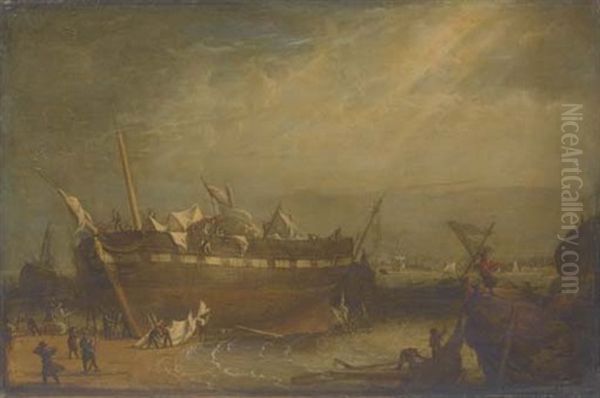
Boston in the late 1820s and 1830s was a city whose identity and prosperity were inextricably linked to the sea. Its harbor teemed with activity – coastal schooners, transatlantic packets, fishing vessels, and newly built clipper ships. For a marine painter like Salmon, it was an ideal location. He quickly established himself within the city's small but growing artistic community.
Significantly, Salmon set up his studio in a small building perched at the end of the Marine Railway Wharf, overlooking the harbor. This unique vantage point, often referred to as his "Marine Pavilion," offered him panoramic views of the waterfront, the constant movement of ships, the changing light on the water, and the developing city skyline. This direct, daily observation deeply informed his American works, allowing him to capture the specific character and energy of Boston's maritime life with unparalleled accuracy and immediacy. His choice of location underscored his dedication to observing his subject matter firsthand.
His arrival filled a niche in the American art scene. While landscape painting was gaining ground, specialized, highly skilled marine painters working in the European tradition were relatively few. Salmon brought with him a level of technical proficiency and a sophisticated understanding of marine subjects that quickly garnered attention. He began receiving commissions from merchants, ship owners, and captains who desired accurate and handsome portraits of their vessels or views of the harbor that symbolized their city's commercial vitality.
The Boston Harbor Views: A New Vision
Robert Salmon's years in Boston, roughly from 1828 until his departure around 1842, were exceptionally productive and marked a distinct evolution in his work. While continuing to paint ship portraits, his focus increasingly turned to panoramic views of the harbor itself, capturing the intricate tapestry of life along the wharves and waterways. These Boston scenes represent the pinnacle of his American period and cemented his reputation.
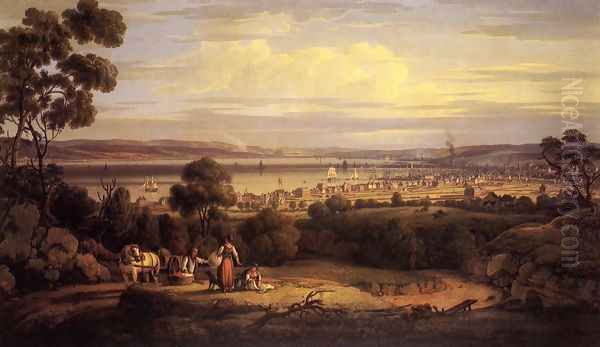
Among his most celebrated works from this time is Boston Harbor from Constitution Wharf (c. 1830-35). This painting exemplifies his mature American style. It presents a wide-angle view across the busy harbor, filled with meticulously rendered ships of various types – moored, sailing, and under construction. The foreground details the activity on the wharf, including figures loading cargo, sailors at work, and gentlemen observing the scene. Beyond, the water reflects the sky and ships, rendered with a clarity and calmness that anticipates Luminism. The distant city skyline, including recognizable landmarks like the State House dome, is depicted with topographical precision. The overall effect is one of vibrant, ordered activity bathed in a cool, clear light.
Salmon created numerous views of Boston's waterfront, often depicting specific wharves like Central Wharf or India Wharf, each bustling with the commerce that fueled the city's growth. Works like The Wharves of Boston (1829) showcase his ability to organize complex scenes into coherent compositions, balancing the detailed rendering of ships and architecture with a sense of atmospheric depth. He captured the specific light conditions of the New England coast – often crisp and clear, unlike the softer, more diffused light frequently found in Britain.
His skill attracted prominent patrons. Wealthy merchants and families, such as Samuel Cabot and Josiah Quincy, commissioned works from him. Ship owners valued his ability to create accurate "portraits" of their vessels, often shown sailing proudly into or out of the harbor. These commissions provided Salmon with financial stability and further integrated him into the city's elite circles. His studio became a known spot, and his paintings were exhibited locally, contributing to the development of Boston's art appreciation and market. Through these works, Salmon not only documented the physical appearance of Boston's harbor but also captured the spirit of maritime enterprise that defined the city in the Jacksonian era.
Salmon's Artistic Signature: Realism and Light
Robert Salmon's artistic style is defined by a compelling combination of meticulous realism and a heightened sensitivity to the effects of light and atmosphere. Throughout his career, he remained committed to the accurate depiction of ships, a skill honed through years of observation and practice. His vessels are rendered with a draftsman's precision, capturing the specific details of rigging, hull design, and flags, which was crucial for satisfying patrons who commissioned portraits of their prized ships. This topographical accuracy extended to his harbor views, where buildings and landmarks are clearly identifiable.
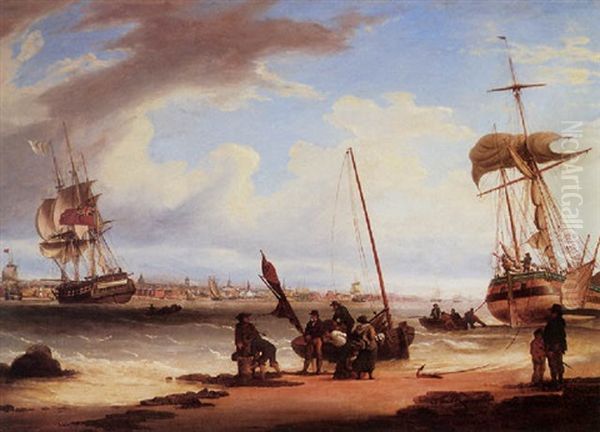
However, Salmon was more than just a recorder of nautical facts. His true distinction lies in his masterful handling of light. While influenced by the idealized, golden light of painters like the 17th-century French master Claude Lorrain, whose work was highly esteemed, Salmon adapted this interest to the specific conditions he observed. His light is often cooler, clearer, and more analytical than Claude's, particularly in his American works. He excelled at depicting the play of sunlight on water, the crispness of reflections on a calm surface, and the subtle gradations of tone in the sky.
This focus on light and atmosphere became increasingly pronounced during his Boston years. He captured the particular clarity of the North American air, rendering distant objects with sharp focus and creating a sense of deep, measurable space. His seas are often depicted with a glassy calmness, allowing for intricate reflections that enhance the feeling of stillness and order. This careful modulation of light, combined with smooth, often invisible brushwork that minimized the artist's hand, created a sense of quiet intensity and heightened realism.
While Salmon could depict stormy seas, particularly in his earlier British works, his American paintings frequently favor calm conditions and bright, clear days. This preference, along with the precise rendering and smooth finish, distinguishes his work from the more turbulent and emotionally charged seascapes of Romantic painters like Turner. Salmon's approach was more objective, focused on capturing the visual phenomena of light and reflection with remarkable fidelity. It is this specific combination of detailed realism and luminous atmosphere that marks his unique contribution and foreshadows the development of American Luminism later in the century.
A Bridge Between Traditions
Robert Salmon occupies a unique and important position as a conduit between European and American painting traditions. Arriving in the United States in 1828, he brought with him the sophisticated techniques and established conventions of British marine painting, which had a long and distinguished history heavily influenced by the Dutch Golden Age masters like the Van de Veldes and Ludolf Bakhuizen. This European heritage provided a strong foundation of technical skill, particularly in the accurate rendering of ships and the dramatic portrayal of the sea.
In America, the art scene was still developing its own distinct identity. While landscape painters like Thomas Cole and Thomas Doughty were beginning to explore the American wilderness, specialized marine painting was less established. Earlier figures like Thomas Birch had worked in the genre, but Salmon introduced a level of detail, atmospheric subtlety, and compositional complexity that was relatively new, particularly in New England.
Crucially, Salmon did not simply replicate his British style in America. He adapted his approach to the new environment. The different quality of light on the American East Coast, often perceived as sharper and clearer than in Britain, found expression in his paintings. His focus shifted partly from naval history and dramatic sea battles (more common subjects in Britain) towards the depiction of bustling commercial harbors and specific ship portraits, reflecting the mercantile focus of cities like Boston.
By successfully integrating his European training with his observations of the American scene, Salmon acted as a vital link. He demonstrated to American artists and patrons the possibilities of marine painting executed with high technical skill and refined aesthetic sensibility. He showed how the established European genres could be applied to American subjects, paving the way for native-born artists to develop their own interpretations of the American maritime experience. His work provided a model of professionalism and technical excellence that helped elevate the status of marine painting in America.
Influence on American Painting: The Seeds of Luminism
Robert Salmon's impact on the course of American art, particularly marine painting in New England, was profound and lasting. His detailed style, combined with his innovative treatment of light and atmosphere, directly influenced several key American artists who followed him, most notably those associated with the Luminist movement that flourished in the mid-19th century.
The most significant connection is with Fitz Henry Lane (also known as Fitz Hugh Lane). Lane, who began his career as a lithographer in Boston during Salmon's residency, almost certainly knew Salmon's work intimately and may have received informal instruction or guidance from the elder painter. Lane's mature style, characterized by crystalline light, glassy water, meticulous detail, and a sense of profound stillness, clearly echoes elements found in Salmon's Boston harbor scenes. While Lane developed these qualities into a more poetic and uniquely American vision, Salmon's work provided a crucial precedent, demonstrating the artistic potential of precisely rendered light and calm, reflective surfaces.
Salmon's influence extended to other painters as well. William Bradford, known for his dramatic paintings of Arctic seascapes and icebergs, shared Salmon's interest in the effects of light on water and ice, albeit often in more extreme conditions. Alfred Thompson Bricher, a later painter associated with Luminism, specialized in coastal scenes and waves, capturing light with a clarity and precision that owes a debt to the tradition Salmon helped establish in New England. Even William Trost Richards, whose work blends Luminist sensibilities with Pre-Raphaelite detail, likely benefited from the high standard of meticulous realism set by Salmon in American marine art. Some sources also suggest a connection with James T. Wright as a possible student, further indicating his role as a mentor.
Beyond specific artists, Salmon helped popularize marine painting and ship portraiture in America. His success demonstrated that there was a market for high-quality depictions of maritime subjects. He set a benchmark for accuracy and atmospheric effect that subsequent artists strove to meet or surpass. By focusing on the specific light and character of the American coast, he encouraged artists to look closely at their own environment. In essence, Robert Salmon planted the seeds from which American Luminism, one of the country's most distinctive contributions to 19th-century art, would grow. His work provided both technical models and thematic inspiration for a generation of painters exploring the unique beauty of the American maritime world.
Character, Catalogue, and Collections
While much of Robert Salmon's life revolved around his meticulous art, contemporary accounts and biographical details offer glimpses of his personality and working methods. He was reportedly somewhat eccentric and reclusive, dedicated intensely to his craft within his waterfront studio. This solitary focus likely contributed to the consistency and high level of detail found throughout his work. His decision to systematically number his paintings, often inscribing the number, date, and sometimes subject on the back of the canvas or panel, was unusual for the time and speaks to a methodical, perhaps even obsessive, nature. This practice, however, has proven invaluable for art historians, most notably John Wilmerding, who compiled a catalogue raisonné of Salmon's work, helping to track his prolific output, which may have exceeded one thousand paintings.
Despite his prolific production, many of Salmon's works are now lost. However, a significant number survive, preserved in major public and private collections, primarily in the United States and Great Britain. The Peabody Essex Museum in Salem, Massachusetts, holds a particularly strong collection, reflecting the historical maritime focus of that institution. Other important holdings can be found at the Museum of Fine Arts, Boston; the National Maritime Museum in Greenwich, London; the U.S. Naval Academy Museum in Annapolis; the Yale University Art Gallery; and the Virginia Museum of Fine Arts, among others. The presence of his work in these prestigious institutions attests to his recognized importance in the history of marine art.
Some mysteries surrounding Salmon's life persist. The exact circumstances of his departure from Boston around 1842 and his final years remain unclear. It is generally believed he returned to Europe, possibly Italy or England, and died sometime around 1844 or 1845, but definitive documentation is lacking. Questions also remain regarding the full extent of his interactions with other artists and the precise nature of his influence on figures like Lane. Conservation efforts on his paintings sometimes reveal details about his techniques but can also raise questions about original intent versus later alterations. These lingering uncertainties add a layer of intrigue to the study of his life and work.
Enduring Legacy
Robert Salmon's legacy is firmly secured in the annals of both British and American art history. As a master of marine painting, he excelled in the detailed and accurate portrayal of ships and harbors, creating invaluable visual records of maritime life in the early 19th century. His British works capture the era of naval power and burgeoning global trade, while his American paintings offer a vivid portrait of Boston's golden age of sail.
His technical proficiency, rooted in the Anglo-Dutch tradition, provided a high standard for marine art in America. Yet, his contribution went beyond mere documentation. Salmon was an innovator in his sensitive and nuanced depiction of light and atmosphere. His ability to capture the crisp clarity of coastal light, the reflective qualities of calm water, and the subtle gradations of the sky set his work apart and marked him as a key precursor to American Luminism.
Through his paintings and his likely influence on younger artists like Fitz Henry Lane, Salmon played a crucial role in shaping the direction of American marine painting. He demonstrated how European traditions could be adapted to American subjects and sensibilities, fostering the development of a distinctly American approach to depicting the sea and shore. His work continues to be admired for its meticulous craftsmanship, its atmospheric beauty, and its historical significance, ensuring Robert Salmon's enduring place as a pivotal figure who navigated the artistic currents between the Old World and the New.